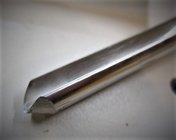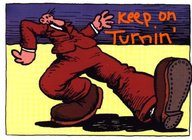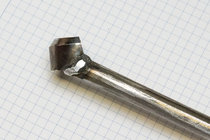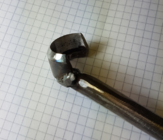odie
TOTW Team
- Joined
- Dec 22, 2006
- Messages
- 7,116
- Likes
- 9,841
Depending on your choice of grinds, the bowl gouge orientation may vary some in finding the very best possible presentation of cutting edge to wood. The principle of applying a sharp edge for getting the very best/cleanest possible finishing cut seems to be a constant, and not the product of the grind shape itself. After years of using the various swept-back grinds using the Wolverine Vari-grind Jig, my current personal choice of grinds is the traditional grind, produced without using the Vari-grind jig, and by using the V-arm exclusively while spinning the gouge along it's longitudinal axis against the grinding wheel. (I am not suggesting anyone change their choices in the types of gouge grinds they use, but to convey the thinking that the principles applied here are the same, because the very tip of the cutting edge is the same, no matter how the shape of the grind leading up to the cutting edge may differ.)
The actual cutting action being the same, the very tip of the bowl gouge cutting edge is stabilized within the cut, from/by three contact points.....the bevel, the tool rest, and your hands. For the purposes of this discussion, I am only discussing the contact point at the tool rest. We may consider this the "fulcrum". At the fulcrum. the gouge cutting edge presentation is adjusted three ways: handle up/down, handle left/right, and along it's longitudinal axis, or a rolling motion throughout the breadth of the cut. The presentation will change dramatically, depending on your choice of tool rest height, as well. The total concept of getting that perfect cut, is the relationship of all these components throughout the cut......and, all of them are in a constant state of change during the breadth of that cut.....and, this is because the profile of the bowl is a curve, and not a straight line. It is a "fluid" motion, and your state of awareness is the key to engineering the perfect cut.
All of the more experienced turners get an "instinct" as to what presentation will produce a "catch", and most of us instinctually avoid going anywhere near it. In recent years, I've been increasingly aware that the best, cleanest possible cut is very close to the presentation that produces "the catch". The closer I can come to having a catch, without actually getting one, is what I've been striving for......and, the results I've been getting have seen incredible improvements in some of my "tool finishes"......tool finishes that require the bare minimum of sanding. (This is the ultimate goal.)
Stated here.....All this is applicable to very light delicate finishing cuts, and absolutely not to be applied to heavy cuts. If you experiment with these principles using heavy cuts, when you do get a catch, it will be much more dramatic, severe, and very dangerous to your safety. (Newbies, take note!)
All of this is related to my previous proclamations about "spiritual turning", but a completely different concept entirely! Although it does apply to some degree, spiritual turning is the ability to perceive through your hands, ears, eyes, and mind.....all while the cutting action is in progress.......
-----odie-----
The actual cutting action being the same, the very tip of the bowl gouge cutting edge is stabilized within the cut, from/by three contact points.....the bevel, the tool rest, and your hands. For the purposes of this discussion, I am only discussing the contact point at the tool rest. We may consider this the "fulcrum". At the fulcrum. the gouge cutting edge presentation is adjusted three ways: handle up/down, handle left/right, and along it's longitudinal axis, or a rolling motion throughout the breadth of the cut. The presentation will change dramatically, depending on your choice of tool rest height, as well. The total concept of getting that perfect cut, is the relationship of all these components throughout the cut......and, all of them are in a constant state of change during the breadth of that cut.....and, this is because the profile of the bowl is a curve, and not a straight line. It is a "fluid" motion, and your state of awareness is the key to engineering the perfect cut.
All of the more experienced turners get an "instinct" as to what presentation will produce a "catch", and most of us instinctually avoid going anywhere near it. In recent years, I've been increasingly aware that the best, cleanest possible cut is very close to the presentation that produces "the catch". The closer I can come to having a catch, without actually getting one, is what I've been striving for......and, the results I've been getting have seen incredible improvements in some of my "tool finishes"......tool finishes that require the bare minimum of sanding. (This is the ultimate goal.)
Stated here.....All this is applicable to very light delicate finishing cuts, and absolutely not to be applied to heavy cuts. If you experiment with these principles using heavy cuts, when you do get a catch, it will be much more dramatic, severe, and very dangerous to your safety. (Newbies, take note!)
All of this is related to my previous proclamations about "spiritual turning", but a completely different concept entirely! Although it does apply to some degree, spiritual turning is the ability to perceive through your hands, ears, eyes, and mind.....all while the cutting action is in progress.......
-----odie-----
Last edited:




